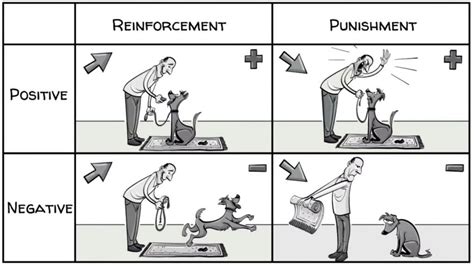Introduction

In the realm of psychology, operant conditioning emerged as a groundbreaking theory developed by B.F. Skinner. This influential concept revolutionized our understanding of behavior, emphasizing the role of observable actions and their consequences. By manipulating environmental contingencies, operant conditioning allows us to shape behavior in desired ways.
The Principles of Operant Conditioning
Operant conditioning is rooted in the premise that behavior is primarily influenced by its outcomes. Positive reinforcement increases the likelihood of a behavior by providing a pleasant consequence, while negative reinforcement increases behavior by removing or avoiding an unpleasant consequence. Conversely, positive punishment decreases the likelihood of a behavior by introducing an unpleasant consequence, and negative punishment decreases behavior by removing or avoiding a pleasant consequence.
Reinforcement Schedules
The timing and frequency of reinforcement play a significant role in the effectiveness of operant conditioning. Four primary reinforcement schedules exist:
Table 1: Reinforcement Schedules
| Reinforcement Schedule | Reinforcement Patter | Examples |
|---|---|---|
| Continuous reinforcement: | Reinforcement each time | Daily rewards for completing tasks |
| Fixed interval: | Reinforcement at regular time intervals | Studying for a test each night |
| Variable interval: | Reinforcement after varying time intervals | Receiving a text message at random times |
| Fixed ratio: | Reinforcement after a set number of responses | Completing 10 push-ups for a snack |
Applications of Operant Conditioning
Operant conditioning has numerous practical applications in various settings:
Education:
- Teachers can utilize positive reinforcement to encourage student participation and academic performance.
- Token economies, where students earn points for appropriate behavior, can foster a positive learning environment.
Healthcare:
- Physical therapists use positive reinforcement to motivate patients during exercise programs.
- Nurses may employ negative reinforcement to discourage undesirable behaviors, such as pulling out IV lines.
Business and Management:
- Employers can implement performance-based bonus systems to reward employees for achieving specific goals.
- Managers may use negative reinforcement to reduce tardiness or absenteeism by requiring employees to work overtime as a consequence.
Positives and Negatives of Operant Conditioning
Positives:
- Reinforces desirable behaviors and reduces undesirable ones.
- Provides a structured approach to behavior change.
- Offers immediate and tangible rewards and punishments.
Negatives:
- Can suppress intrinsic motivation and creativity.
- May lead to over-reliance on external rewards.
- Potential for ethical concerns.
Extending Operant Conditioning with Skinner’s Box
B.F. Skinner developed the Skinner box, a controlled environment that allowed him to study the effects of reinforcement on behavior. In this setup, animals could access food or other reinforcers by performing特定的 responses. Skinner’s research provided valuable insights into the principles of operant conditioning.
Current Trends and Future Directions
Operant conditioning remains a widely used and effective technique in psychology and behavior analysis. Researchers continue to explore new applications and refine existing methods. One emerging trend is the use of gamification, which incorporates game-like elements into learning and behavioral interventions.
Conclusion
Operant conditioning has proven to be a versatile and impactful tool in the field of psychology. By understanding the principles and applications of this theory, we can effectively shape behavior and promote positive outcomes. As the field continues to evolve, operant conditioning will undoubtedly remain a cornerstone of behavior analysis and a valuable asset for shaping desired behaviors in various contexts.
